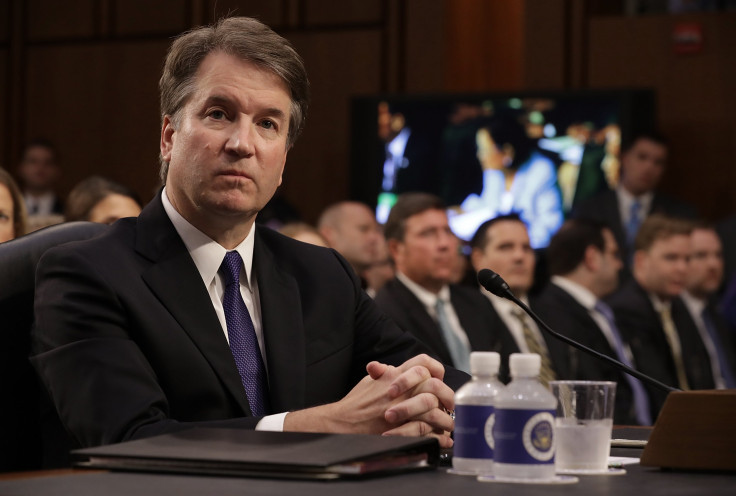Chris Garrett, Who Ed Whelan Named Arbitrarily, Was Among Kavanaugh’s Character Witnesses

A bizarre theory posted online Thursday claimed Supreme Court nominee Brett Kavanaugh could be exonerated from accusations of sexual assault brought against him by Christine Blasey Ford because it was not Kavanaugh but a supposed look-alike who may have carried out the alleged attack over three decades ago.
The theory in question was drawn up and posted on Twitter by Ed Whelan, a former clerk to the late justice Antonin Scalia and president of the conservative think tank Ethics and Public Policy Center. Whelan used floor plans of a building that he said matched Ford's description of the location where the alleged attack took place, and posted photographs of Christopher C. Garrett — a former classmate of Kavanaugh and Ford — claiming the man bore a striking resemblance to the Supreme Court nominee and said it was evidence to prove Kavanaugh was innocent of the charges against him.
Whelan began his string of tweets by saying, “Dr. Ford may well have been the victim of a severe sexual assault by someone 36 years ago. Her allegations are so vague as to such basic matters as when and where that it is impossible for Judge Kavanaugh to *prove* his innocence.”
Although Ford never provided the exact address of the house where Kavanaugh allegedly assaulted her during a gathering of friends, only vaguely saying “it was a suburban Maryland area home” that was “not far from” the Columbia Country Club, Whelan pulled up the floor plans to a house — owned by Garrett — in the locality and began analyzing how the incident might have unfolded.
Whelan went on to match a “short stair well” running up from the foyer to the living room and the location of the bedroom of the house picked by him to the kind described by Ford. He even mentioned the "family room" - a similar room where Ford alleged the attack took place - which was shielded from the view of the staircase.
After painting a vivid picture of the alleged attack, Whelan presented his next evidence – Garrett's supposed resemblance to Kavanaugh.
Implying that Ford could have easily mistaken Garrett for Kavanaugh, Whelan also pointed out that Garrett was friends with Mark Judge, one of the four individuals Ford named as being present at that gathering and being witness to the incident. To do this, Whelan cited a comment that Garrett had left below Judge’s Facebook post from June 2012.
While casting suspicion on Garrett as Ford’s potential attacker, Whelan was careful to maintain probable deniability. “To be clear, I have no idea what, if anything, did or did not happen in that bedroom at the top of the stairs, and I therefore do not state, imply or insinuate that Garrett or anyone else committed the sexual assault that Ford alleges,” Whelan wrote.
In a statement to the Washington Post, Ford said it was impossible she would mistake Kavanaugh for Garrett. “I knew them both, and socialized with” Garrett, she said, adding that she had once visited him in the hospital. “There is zero chance that I would confuse them.”
Incidentally, as pointed out by Josh Marshall, the founder of Talking Points Memo, Garrett was one of character witnesses for Kavanaugh’s character in a letter submitted to the Senate Judiciary Committee in July.
Good lord! This is too perfect. The guy they slimed as the real culprit is one of the alums who signed a letter to the senate attesting to Kavanaugh’s character! https://t.co/W5474G3gAi thx @DoremusJ pic.twitter.com/Yw6Av8URYn
— Josh Marshall (@joshtpm) September 21, 2018
It is important to note in this regard that Whelan is friends with both Kavanaugh and Leonard Leo, the head of the Federalist Society, who has been helping to spearhead the Supreme Court nomination.
While both the White House and the Senate Judiciary Committee distanced themselves from Whelan’s theory, claiming they were not aware of his plans to identify the former classmate, many others said Whelan could face legal charges for defaming a private citizen. CNN’s Jake Tapper called Whelan’s tweets “stunningly irresponsible.”
A prominent DC conservative, trying to promote an alternate theory that someone else (and not Kavanaugh) may have sexually assaulted Professor Ford, named that person, showed photographs suggesting Ford confused the two and more. This is stunningly irresponsible.
— Jake Tapper (@jaketapper) September 20, 2018
© Copyright IBTimes 2025. All rights reserved.






















